Trading has evolved from a solitary activity into a highly collaborative endeavor. Social trading platforms are at the forefront of this shift, creating vibrant ecosystems where investors can connect, share insights, and even replicate the strategies of seasoned market professionals. This guide is designed to help you navigate this dynamic space and identify the best social trading platforms tailored to your specific needs. We cut through the marketing hype to provide a detailed, side-by-side analysis of the top options available.
Our comprehensive review dissects each platform, examining its core features, fee structures, community sentiment, and regulatory compliance. We explore two primary categories to clarify your choices:
- Automated Copy Trading Platforms: These services allow for the direct, automated mirroring of other traders' portfolios, ideal for a more hands-off approach.
- Community-Focused Social Networks: These platforms emphasize discussion, idea sharing, and market analysis without direct portfolio replication, perfect for traders who want to enhance their own decision-making process.
For each entry, you will find a breakdown of its unique value proposition, practical use cases for different trader profiles (from day traders to long-term investors), and an honest assessment of its strengths and limitations. Complete with screenshots and direct links, this resource provides the clarity you need to determine whether an automated strategy or community-driven insight best aligns with your investment philosophy, risk tolerance, and desired level of portfolio control. Let's find the right platform to enhance your trading strategy.
1. eToro
As a pioneer in the social investing space, eToro solidifies its position as one of the best social trading platforms, especially for those new to the concept. Its core strength lies in its intuitive design, making the process of finding and copying experienced traders remarkably straightforward. The platform excels at transforming complex trading decisions into a simple, social media-like experience.
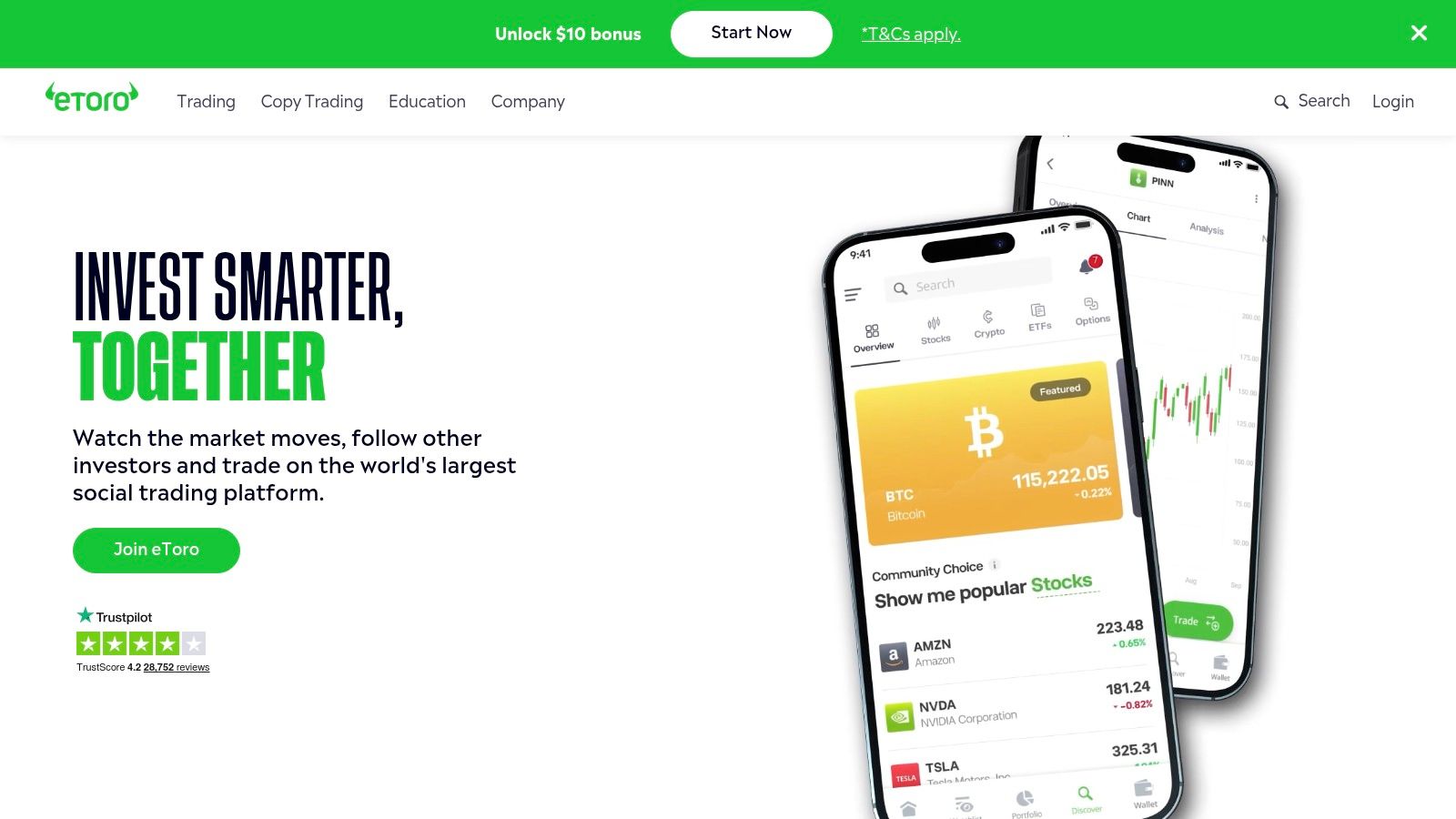
The user interface is clean and highly visual, allowing you to browse through profiles in the "Popular Investor" program, view detailed performance statistics, and allocate funds to copy their trades with just a few clicks. For U.S. users, this functionality is currently focused exclusively on cryptocurrency trading.
Key Features and User Experience
eToro's platform is built around its flagship CopyTrader™ feature. This tool automatically mirrors the trades of your chosen investor in real-time, proportionally to the funds you've allocated. It’s a hands-off approach that appeals to beginners or those with limited time for market research.
- Social Feed: A built-in news feed allows you to interact with other traders, share insights, and gauge community sentiment on specific assets.
- Virtual Portfolio: Every user gets a free $100,000 demo account. This is a crucial tool for practicing the copy trading mechanism and testing strategies without risking real capital.
- Pricing: There are no additional management or copy fees. Users only pay the standard trading fees and spreads associated with the assets being traded.
Limitations and Practical Considerations
The primary limitation for U.S.-based traders is the asset restriction; copy trading is crypto-only and the list of supported tokens is limited compared to global offerings. Furthermore, eToro is not available in several states, including New York, Nevada, and Hawaii, due to regulatory constraints. Despite these geographic and asset-class limitations, its ease of use and strong community features make it an excellent entry point into social trading.
Website: https://www.etoro.com/en-us
2. dub
As one of the few U.S.-regulated platforms built specifically for copy trading, dub offers a modern and mobile-first approach to social investing. Its primary appeal is for traders seeking a dedicated copy trading environment that operates within the U.S. regulatory framework, including SEC registration and SIPC coverage. The platform centers on allowing users to subscribe to and automatically mirror the portfolios of verified investors and creators.
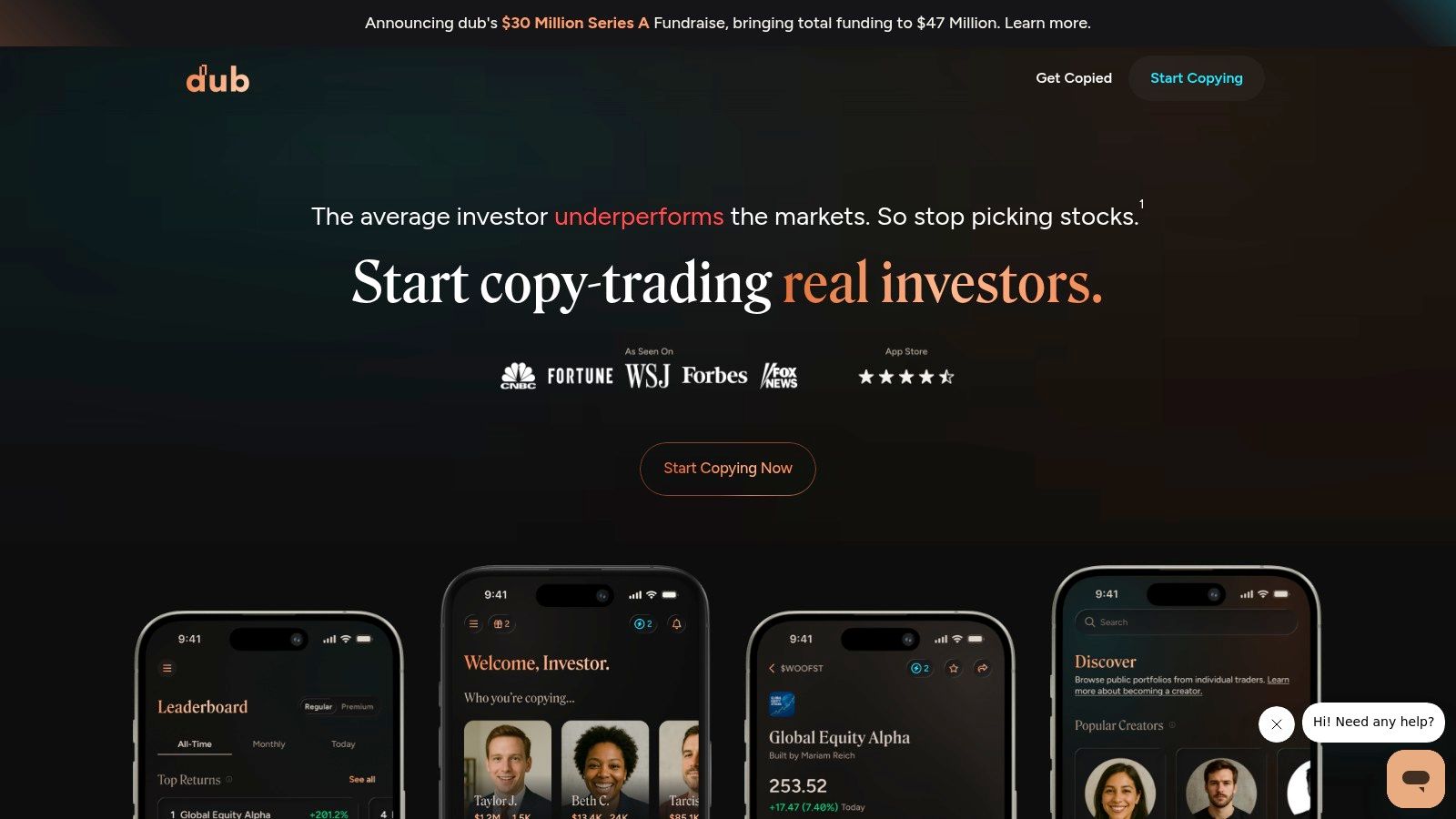
The experience is streamlined through its iOS app, which boasts over a million downloads. Users can browse a marketplace of creators, analyze their investment strategies, and subscribe to auto-follow their trades in real-time. This model is designed for investors who want direct, in-app trade execution without the complexity of external integrations.
Key Features and User Experience
dub's core function is its auto-follow capability, which enables users to replicate a creator’s portfolio moves automatically. The platform emphasizes transparency by verifying its creators and providing performance data to help users make informed decisions. Its clean, app-based interface makes it highly accessible for on-the-go portfolio management.
- Verified Creator Marketplace: Discover and subscribe to a curated list of investors, with clear performance metrics available for review.
- Regulated and Insured: As an SEC-registered broker-dealer and RIA, accounts are protected by SIPC coverage, a significant advantage in the social trading space.
- Pricing: The platform uses a subscription model for full access to copy trading features, coupled with low minimum deposit requirements to get started.
Limitations and Practical Considerations
The main consideration for users is the subscription-based pricing, which is a different model compared to platforms that monetize through spreads. Additionally, while the marketplace of verified creators is growing, it is not as expansive as larger, more established global platforms. This might limit the diversity of available strategies for some users. However, for those prioritizing a U.S.-regulated and specialized copy trading experience, dub stands out as one of the best social trading platforms available.
Website: https://www.dubapp.com
3. Collective2
Collective2 operates less like a social network and more like an open marketplace for trading strategies, making it one of the best social trading platforms for experienced investors seeking diversification. It connects subscribers with independent "strategy managers," allowing users to automatically replicate trades across stocks, options, futures, and forex directly within their own brokerage accounts. This model offers a high degree of separation and control, appealing to those who prefer a more vendor-neutral approach.
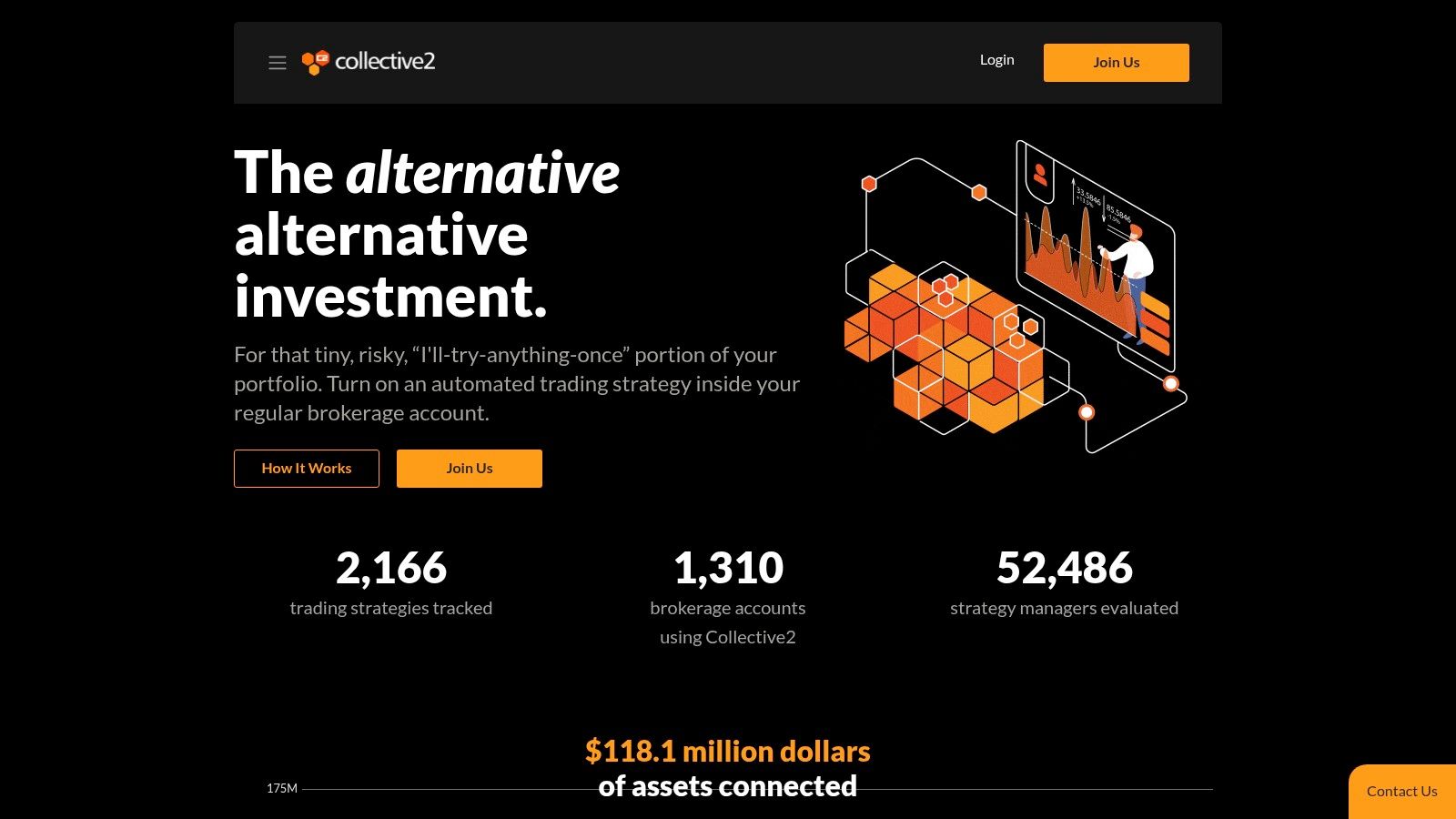
The platform is known for its wide-ranging asset support and compatibility with numerous popular brokers, including Interactive Brokers and TD Ameritrade. This flexibility allows traders to find and subscribe to strategies that align with their specific risk tolerance and investment goals, from conservative stock picking to aggressive futures algorithms.
Key Features and User Experience
Collective2’s core strength is its AutoTrade technology. This system acts as a bridge, receiving signals from a strategy manager and executing them automatically in your linked brokerage account. This provides a hands-off experience while maintaining full ownership and control of your capital and positions.
- Broad Asset and Broker Support: Unlike many platforms limited to specific assets, Collective2 supports stocks, options, futures, and forex, connecting with dozens of brokerages.
- Granular User Control: Subscribers can adjust trade sizing, set their own risk limits, and manually intervene to close a position at any time, overriding the automated strategy.
- Signals-Only Option: For those who prefer manual execution, you can subscribe to receive trade signals via email or other notifications instead of using full automation.
Limitations and Practical Considerations
The platform's primary drawback is its cost structure. Users must pay two separate fees: a monthly subscription to the strategy manager (which varies widely) and a separate monthly fee to Collective2 for the AutoTrade plan. This dual-fee model can make it more expensive than all-in-one platforms. Furthermore, the sheer volume of strategies can be overwhelming, requiring significant due diligence from the user to vet and select a suitable manager.
Website: https://trade.collective2.com
4. TradingView
While not a traditional copy trading platform, TradingView is arguably the largest and most influential social network for traders and investors. It stands out by combining best-in-class charting tools with a vibrant community, making it an indispensable resource for technical analysis and idea generation rather than automated trade replication. Its strength lies in its collaborative environment where users share, discuss, and critique trading ideas in real-time.
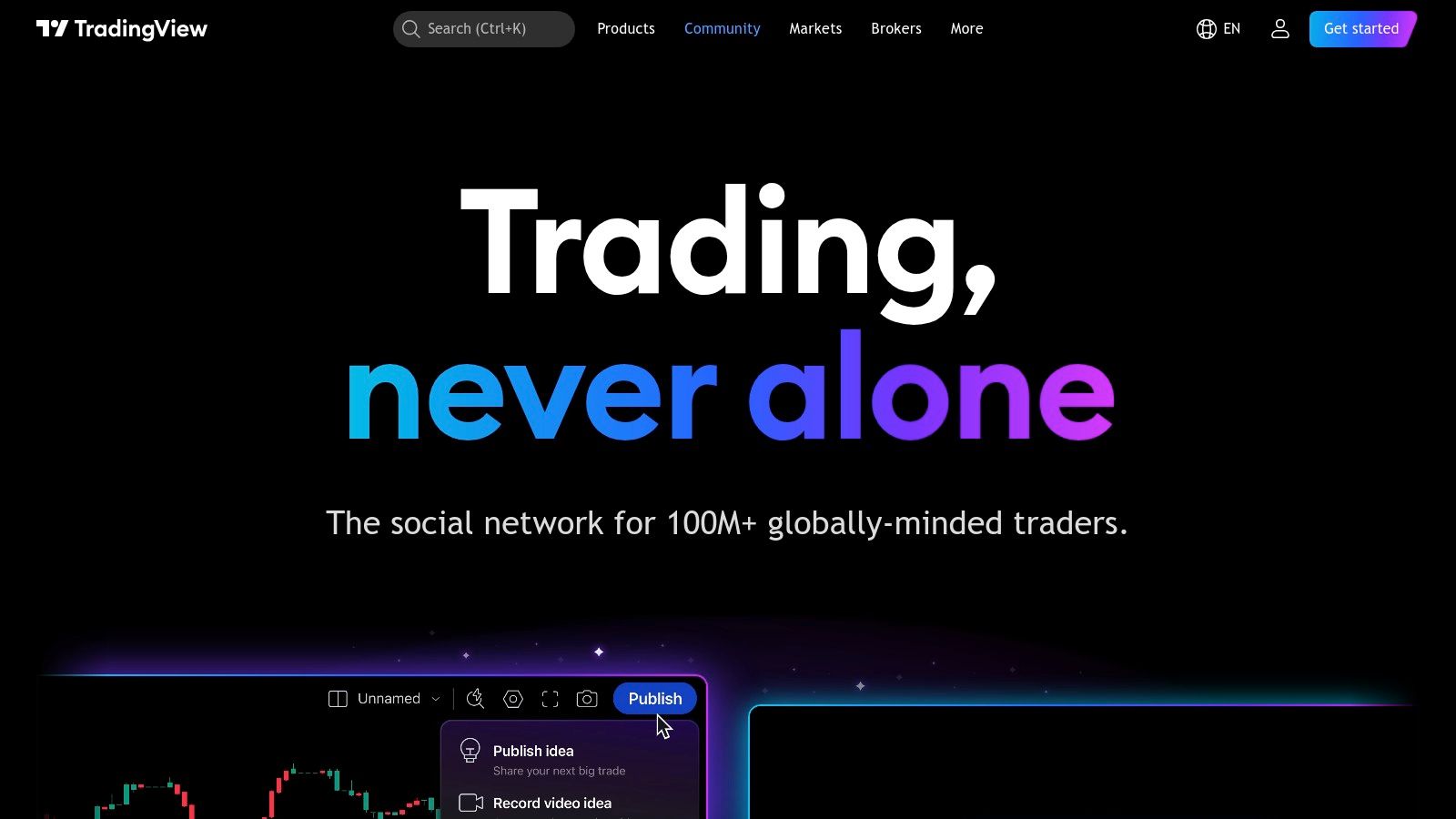
The platform functions as a social hub built around financial charts. Users publish "Ideas" (their market analysis), "Scripts" (custom indicators), and live stream their trading sessions, creating a massive, searchable library of community-generated insights for nearly any asset imaginable.
Key Features and User Experience
TradingView's social features are deeply integrated with its powerful charting interface, allowing for a seamless transition from analysis to discussion. Instead of copying trades, users follow top authors to see their market analysis and can even apply community-built indicators directly to their own charts.
- Ideas and Social Feeds: Every asset has a dedicated social feed where users publish chart-based analyses, forecasts, and educational content for others to view and debate.
- Scripts and Indicators: A vast, open-source library of custom indicators and strategies built by the community using Pine Script™, which can be used to backtest different trading strategies.
- Broker Integration: You can connect a supported brokerage account (like TradeStation or Interactive Brokers) to place trades directly from TradingView's charts, though this is a manual process.
Limitations and Practical Considerations
The most significant distinction is that TradingView does not offer automated copy trading. It is a platform for social analysis and manual trading, not a hands-off investment solution. To act on an idea you find, you must execute the trade yourself through an integrated or separate broker. While many core charting and social features are free, advanced functionalities like multi-chart layouts and more indicators require a paid subscription. For those who want community insights to inform their own decisions, it is one of the best social trading platforms available.
Website: https://www.tradingview.com/social-network/
5. Stocktwits
Originally a social media platform built for traders, Stocktwits has evolved into a fully integrated experience, making it one of the best social trading platforms for those who thrive on real-time market chatter. It combines a vibrant, ticker-tagged social feed with direct, in-app trading capabilities, allowing users to gauge community sentiment and execute trades without leaving the platform.
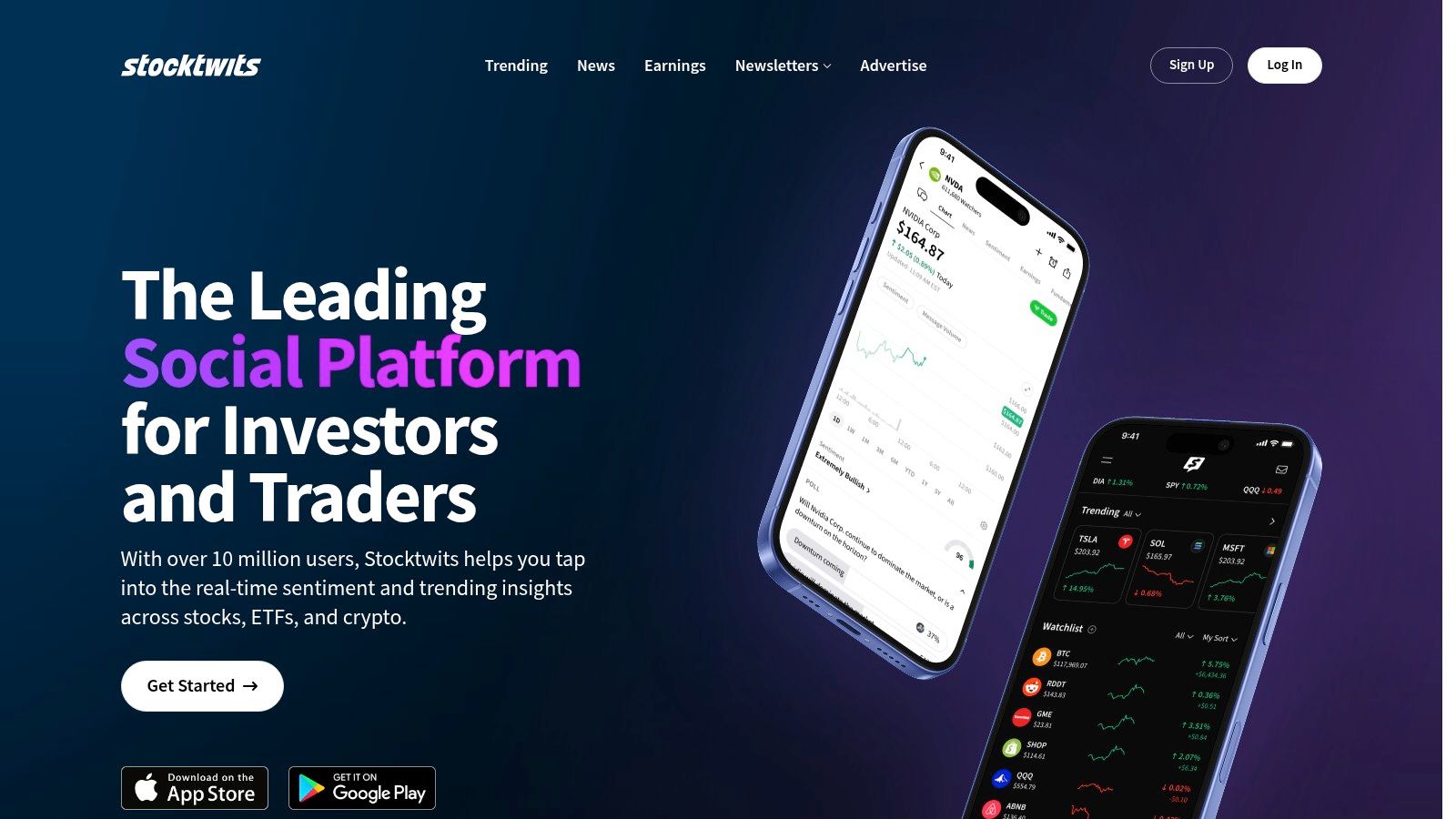
The platform is renowned for its massive and highly active retail investor community. Its core strength is the firehose of live commentary on stocks, options, and crypto, making it a powerful tool for discovering trending assets and understanding the immediate emotional pulse of the market.
Key Features and User Experience
Stocktwits' unique value comes from merging its social roots with a broker-dealer, Stocktwits Brokerage Inc. This allows for a seamless transition from social discovery to trade execution, particularly for stocks and options. Its sentiment tools are a core part of the experience. For those interested in this approach, you can learn more about social sentiment analysis tools.
- Real-Time Social Streams: Users follow specific ticker symbols (e.g., $AAPL) to see a curated feed of posts, charts, and sentiment from other traders.
- In-App Trading: Execute stock and options trades directly within the app, leveraging the social insights you gather in real time.
- Trending Tickers & Sentiment Data: The platform highlights assets with unusual social activity and provides a "Bullish" vs. "Bearish" sentiment score based on user posts.
- Pricing: The social platform is free to use, with an optional ad-free subscription. Standard brokerage fees apply to trades.
Limitations and Practical Considerations
The platform's greatest strength, its massive social feed, is also a potential weakness. It can be filled with a high level of noise, hype, and unverified claims, requiring users to be discerning. Over-relying on the platform's raw sentiment data without conducting further research can be risky. Despite this, for traders who can filter the noise, Stocktwits offers an unparalleled real-time window into retail market psychology.
Website: https://stocktwits.com
6. Commonstock
Commonstock takes a unique approach to social trading by focusing on verified performance and transparency. Instead of being a brokerage itself, it acts as a social layer that connects to your existing U.S. brokerage accounts. This design choice tackles a common problem in financial social media: unverified claims and "paper trading" gurus. By linking real brokerage data, it ensures that the trades and portfolio performance you see are authentic.
The platform functions like a specialized social network for investors. Users share their trades, which are automatically verified, along with the reasoning behind their decisions. This fosters a community built on credibility and data-driven discussion, making it one of the best social trading platforms for those who value authenticity over hype.
Key Features and User Experience
Commonstock’s core value lies in its verification system. By linking accounts from brokerages like Robinhood, Fidelity, and Schwab, the platform provides a credible feed of investment ideas and performance tracking. It is less about automated copying and more about collaborative discovery.
- Brokerage Linking: Securely connect your existing investment accounts to share verified positions and performance, adding a layer of trust to all interactions.
- Social Feed: Follow top investors and see real-time alerts when they buy or sell, complete with their commentary and analysis. You can engage in discussions directly on these trade memos.
- Discovery Tools: Explore trending assets, see what top-performing investors are holding, and discover new investment theses backed by real portfolio data.
Limitations and Practical Considerations
The most significant limitation is the absence of a native copy trading function. Commonstock is purely a social and informational platform; you cannot automatically mirror another user's portfolio. To act on an idea, you must manually execute the trade in your own brokerage account. This makes it unsuitable for users seeking a hands-off, automated solution. The platform is also primarily focused on the U.S. market and equities, with less emphasis on other asset classes.
Website: https://commonstock.com
7. Webull
Webull positions itself as a powerful trading platform first, with a robust social community integrated directly into its app. Rather than focusing on automated copy trading, Webull emphasizes peer-to-peer discussion and idea generation, making it one of the best social trading platforms for active traders who want community input without sacrificing advanced tools.
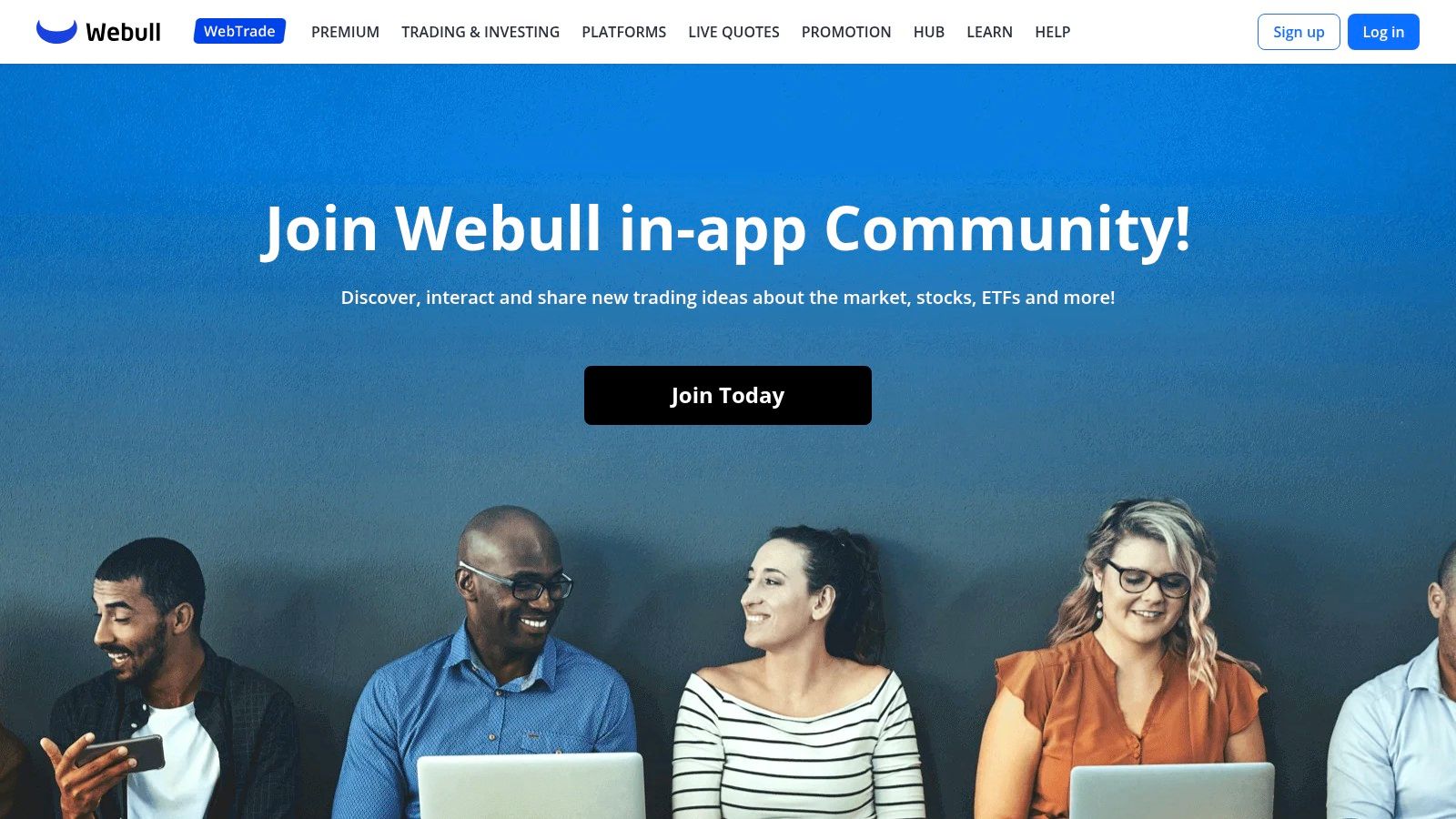
The platform seamlessly combines a commission-free U.S. brokerage with a social feed where users can post analyses, create polls, and comment on market news. Its standout feature is the integration with TradingView, allowing users to leverage world-class charting while participating in community discussions, all within a single ecosystem. This blend of professional-grade tools and social interaction is ideal for those who manage their own trades.
Key Features and User Experience
Webull's community feature is a hub for active discussion centered around specific stocks or the market in general. It serves as a valuable resource for gauging sentiment and discovering trading ideas from a large and active user base. You can explore a deeper review of Webull for beginner traders to see if it fits your needs.
- Integrated Social Feed: Comment and post directly on the pages for stocks, ETFs, and cryptos you are watching.
- TradingView Charts: Access advanced charting tools and technical analysis indicators, a feature often missing from more socially-focused platforms.
- Paper Trading: Practice your strategies with a virtual portfolio before committing real funds, allowing you to test ideas you find in the community.
Limitations and Practical Considerations
The biggest distinction is the lack of an automatic copy trading feature. You cannot simply mirror another user's portfolio. The social feed's quality can also be mixed, with valuable insights sometimes buried among noise and speculation. It requires traders to actively filter information and conduct their own due diligence rather than passively following others. Despite this, its low costs and strong feature set make it a top choice for self-directed social traders.
Website: https://www.webull.com/feature/community
8. moomoo
While not a traditional copy trading platform, moomoo carves out a niche as one of the best social trading platforms for its vibrant and highly engaged community features. It integrates social interaction directly into a powerful trading app, creating a space for U.S.-based traders to connect, share ideas, and learn from one another in real-time. The platform emphasizes community learning and discourse over automated trade mirroring.
The user experience is centered around the "Community" tab, which functions like a dedicated social network for investors. Here, you can follow popular users, join topic-based channels called "Servers," and participate in discussions ranging from specific stock analysis to broad market trends.
Key Features and User Experience
moomoo's strength is its structured and moderated social environment. Instead of automated copying, it provides the tools for manual research and idea generation, supported by a large and active user base. This makes it ideal for traders who want social input without relinquishing direct control over their trades.
- Social Feeds and Servers: Users can post analyses, charts, and opinions. The "Servers" feature organizes discussions into dedicated channels, making it easy to find information on specific topics like options trading or EV stocks.
- Live Streams and Events: The platform regularly hosts live video streams and educational events, allowing users to interact directly with experienced traders and analysts.
- Paper Trading: A robust paper trading feature lets users test strategies and ideas gathered from the community without risking real money.
Limitations and Practical Considerations
The most significant limitation is the complete absence of automated copy trading. If you are looking for a hands-off solution, moomoo is not the right choice. The value derived from its social features is entirely dependent on user participation and the quality of the content within specific channels, which can vary. However, its strong emphasis on community safety and fraud prevention makes it a secure environment for new investors to learn and interact.
Website: https://www.moomoo.com/community
9. Robinhood Social
Robinhood Social represents the popular commission-free broker's entry into the social trading sphere, aiming to leverage its massive U.S. user base. Rather than offering automated copy trading, it functions as a verified in-app social network where users can follow other traders, view their real-time trades, and discuss strategies across various assets. This approach focuses on transparency and community-driven idea generation.
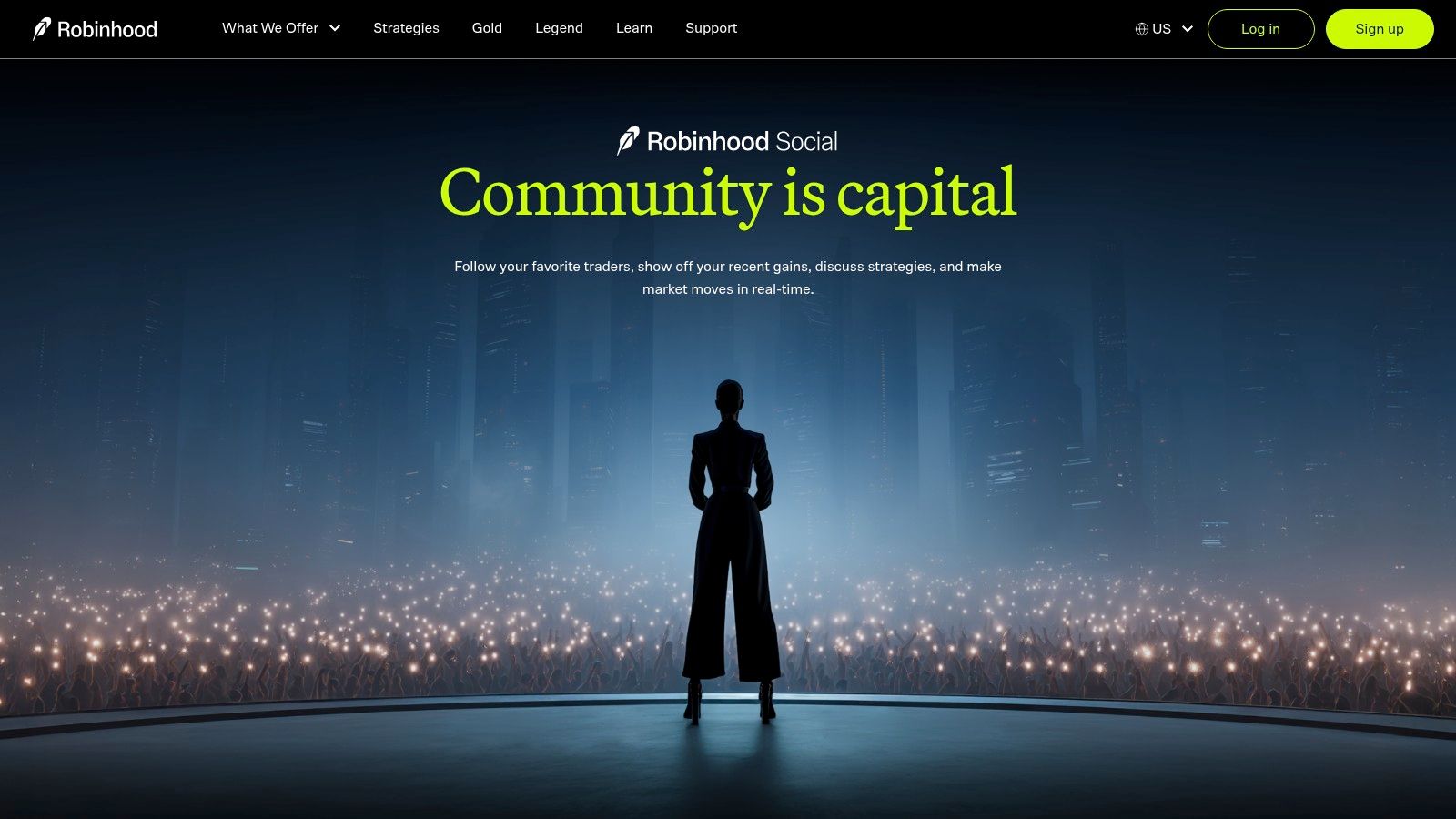
The platform’s key differentiator is its verification system. Users can see actual trades from followed accounts, which helps cut through the noise and unsubstantiated claims common on other social media platforms. The experience is designed to be seamless, allowing users to move from discussion to execution within the same app.
Key Features and User Experience
Robinhood Social is built directly into the familiar Robinhood app, providing an integrated experience for its existing customers. The core idea is to foster a community where investment ideas can be shared and validated by observing real, verified portfolio activity.
- Verified Feeds: Follow other Robinhood users and see a feed of their actual, verified trades in real-time. This adds a layer of authenticity not found in typical trading forums.
- Integrated Trading: Since the feature is part of the main app, you can manually replicate a trade you find interesting with just a few taps, covering stocks, options, and crypto.
- Cross-Asset Discussions: The community-centric design encourages conversations around a wide range of assets, from individual stocks and ETFs to cryptocurrencies.
Limitations and Practical Considerations
The primary limitation is its current availability. Robinhood Social is in an early-stage rollout, accessible by invite or beta only, and is being gradually released across the U.S. A major distinction is that it does not offer automated copy trading; users must manually execute any trades they wish to replicate. While the integrated nature is a huge plus, its newness means the community and features are still developing.
Website: https://robinhood.com/us/en/social
10. MetaTrader Signals (MQL5)
For traders already embedded in the MetaTrader ecosystem, MQL5 Signals offers a native and powerful solution for social trading. Instead of being a standalone brokerage, it's the official marketplace from MetaQuotes, integrating directly into the MT4 and MT5 platforms. This allows users to subscribe to thousands of signal providers and have their trades copied automatically to their own broker account.
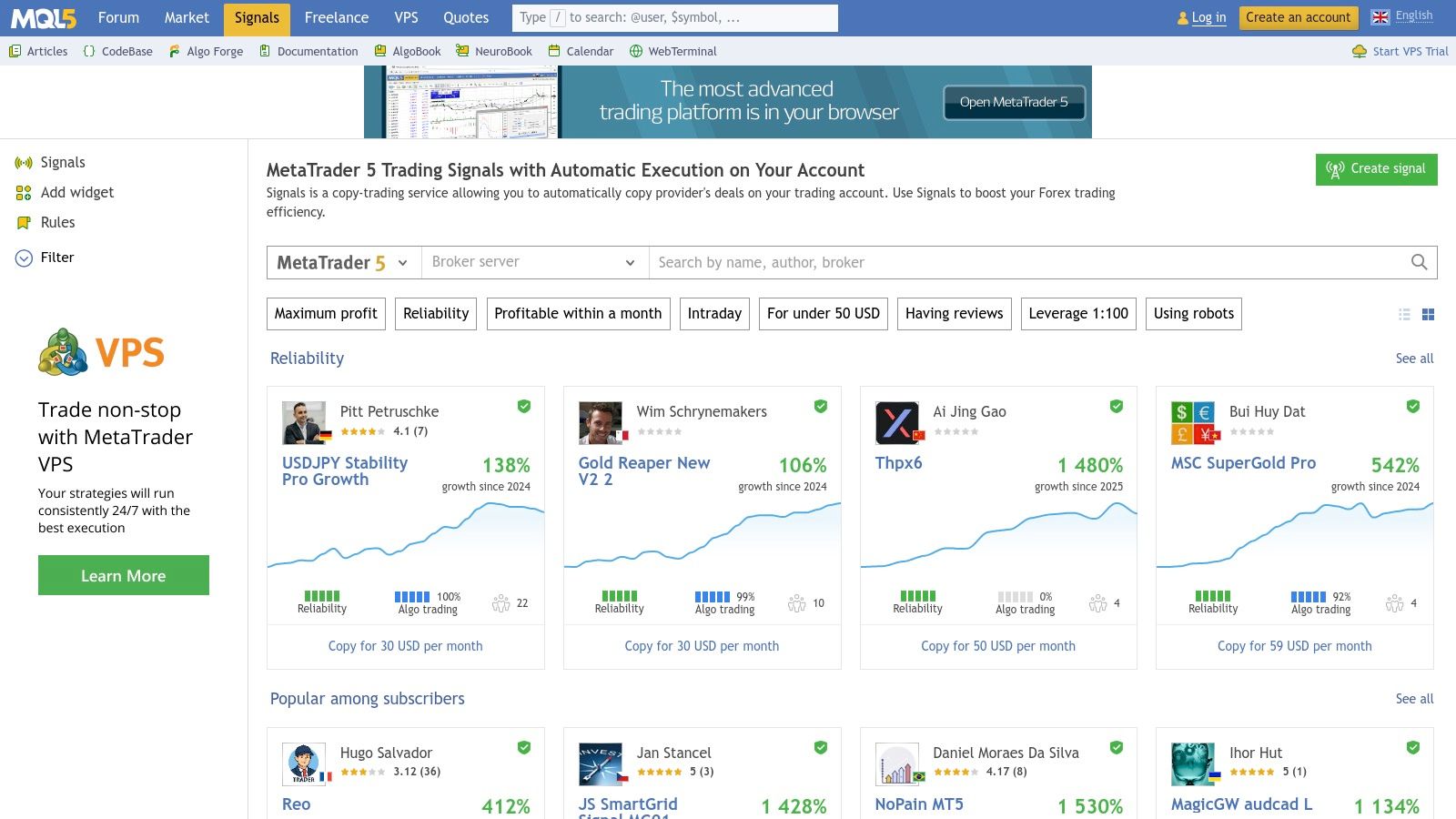
The platform's strength is its direct integration and the sheer volume of available signals. Users can browse an extensive catalog of providers, filtering by performance metrics like growth, maximal drawdown, and subscriber count. This approach puts control firmly in the hands of the user, who retains full custody of their funds with their preferred MetaTrader-compatible broker.
Key Features and User Experience
MQL5 Signals is less a social network and more a direct-to-consumer signal marketplace. The process involves finding a provider on the MQL5 website, subscribing (for a fee or for free), and configuring your MT4/MT5 terminal to execute the trades.
- Vast Signal Provider Marketplace: Offers one of the largest selections of signal providers, catering to various strategies and risk appetites across forex, indices, and commodities.
- Detailed Analytics: Each provider profile includes in-depth statistics and historical performance data, allowing for rigorous due diligence before subscribing.
- Broker Independence: You connect your existing brokerage account, meaning you are not tied to a specific platform's spreads or execution policies.
Limitations and Practical Considerations
The biggest challenge is quality control. With thousands of providers, the results can vary dramatically, and identifying consistently profitable signals requires significant research. The user experience is more technical than on platforms like eToro, demanding a working knowledge of the MetaTrader platform. For U.S. traders, availability depends entirely on finding a domestic broker that still offers MT4 or MT5 access, which has become less common.
Website: https://www.mql5.com/en/signals
11. Interactive Advisors (by Interactive Brokers)
Interactive Advisors, backed by the powerhouse brokerage Interactive Brokers, offers a more regulated and professionally managed approach to social investing. Instead of copying individual retail traders, this SEC-registered advisor marketplace allows you to co-invest alongside professional portfolio managers. It bridges the gap between traditional robo-advisors and copy trading, providing access to hundreds of actively managed, thematic portfolios with full transparency.
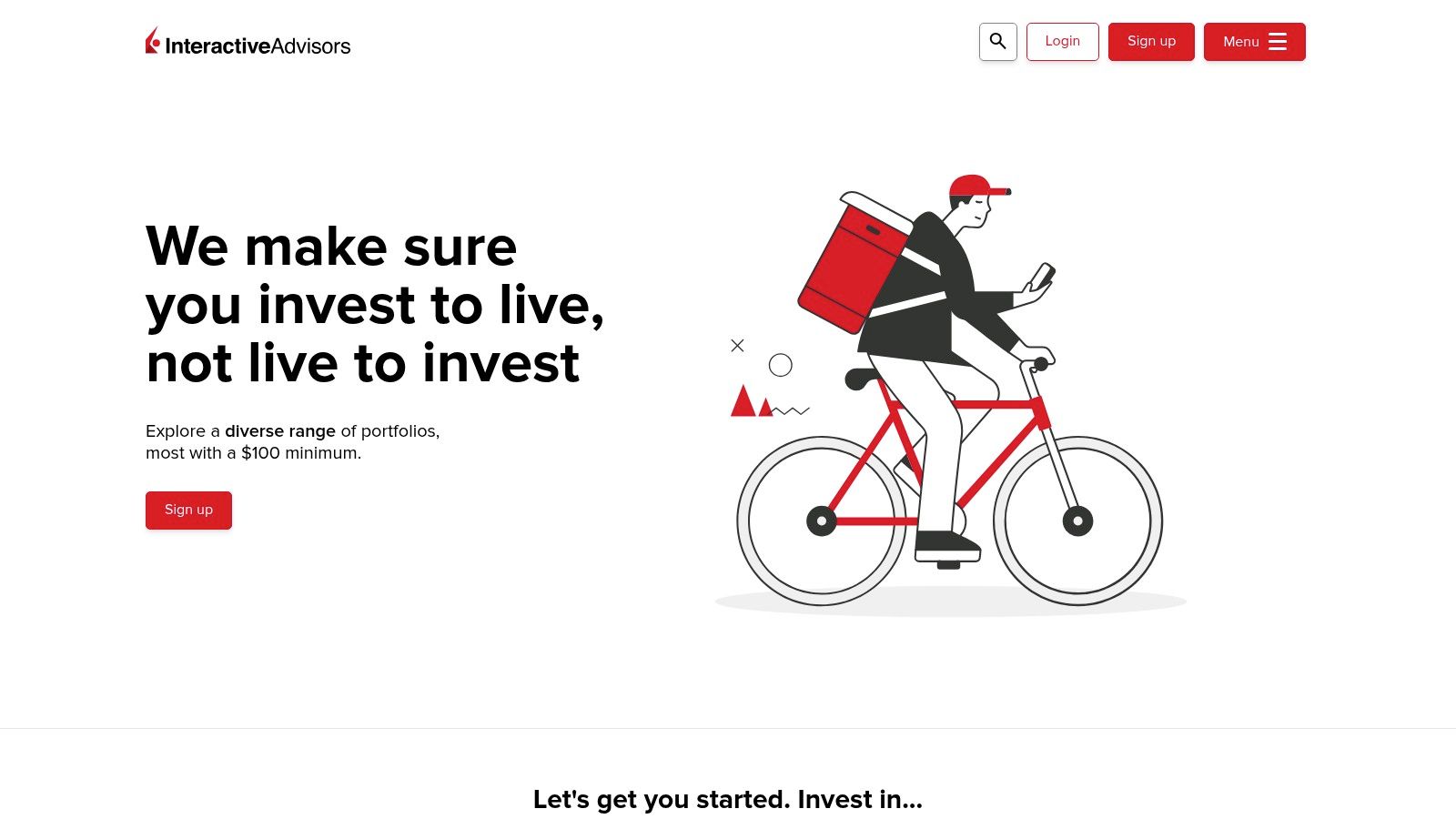
The platform stands out for its low barrier to entry and professional oversight, making it a compelling choice for those who want a hands-off strategy managed by vetted professionals. Its integration with Interactive Brokers ensures robust custody and execution for all trades.
Key Features and User Experience
Interactive Advisors focuses on providing automated, real-time replication of trades made within its professionally managed portfolios. The client dashboard is clean and provides a clear overview of performance, holdings, and manager activity. Its support for fractional shares ensures your investment is allocated precisely according to the model portfolio's strategy, regardless of your investment size.
- Professionally Managed Portfolios: Choose from hundreds of portfolios with varying themes, risk levels, and strategies, all run by registered investment advisors.
- Low Minimums: You can get started with an investment as low as $100, making professional management highly accessible.
- Transparent Pricing: The platform charges a single, simple annual advisory fee ranging from 0.08% to 1.5%, depending on the portfolio. There are no additional trading commissions.
Limitations and Practical Considerations
The primary drawback is the platform's asset limitation. All portfolios are restricted to U.S. stocks and ETFs only, with no support for options, futures, forex, or cryptocurrencies. This makes it unsuitable for traders seeking a diversified, multi-asset copy trading experience. While it offers professional management, it lacks the direct community interaction and social feed common on other platforms, positioning it less as a "social" network and more as a marketplace for managed strategies.
Website: https://interactiveadvisors.com
12. Benzinga
While not a trading platform itself, Benzinga earns its spot as an essential resource for anyone researching the best social trading platforms. It provides expertly curated, comparative guides that break down the top contenders in the market. Think of it as a crucial first step in your due diligence process, offering a high-level overview to quickly evaluate options based on fees, features, and U.S. availability.
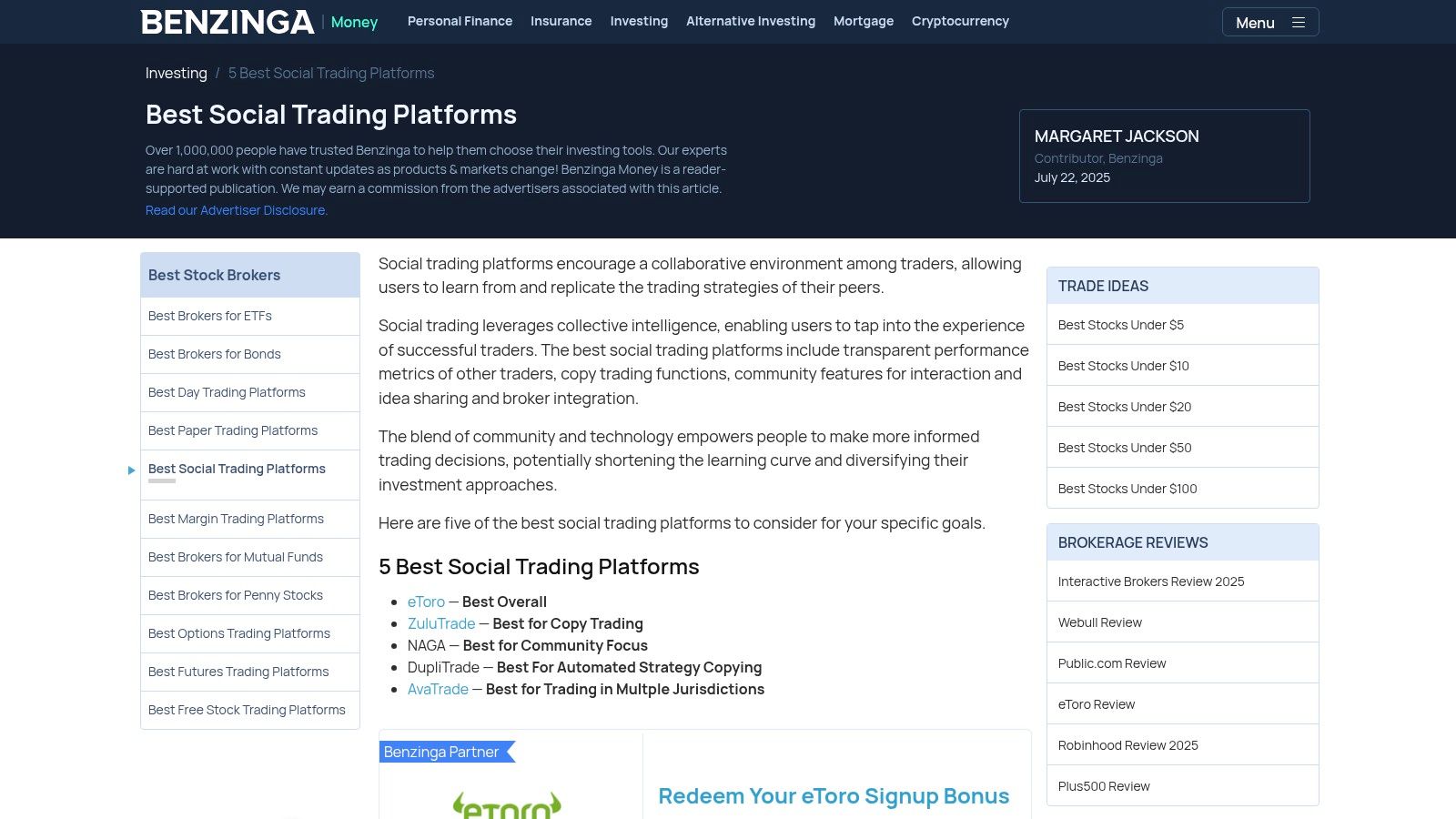
The platform distills complex information into easy-to-digest summaries, helping traders navigate the often-confusing landscape of social and copy trading services. Its value lies in its editorial curation and frequent updates, ensuring the information remains relevant in a fast-moving industry.
Key Features and User Experience
Benzinga's main offering is its comprehensive, frequently updated listicle that summarizes key data points for direct comparison. This allows you to create a shortlist of platforms that fit your specific needs before diving deeper into each one.
- Curated Summaries: The content clearly outlines core features, fee structures, and the pros and cons of each platform, saving users significant research time.
- U.S. Focus: It provides helpful notes on regulatory status and availability within the United States, a critical consideration for American traders.
- Direct Access: The guide includes direct links to official platform websites and sign-up pages, streamlining the process once you've made a decision.
Limitations and Practical Considerations
The primary limitation is that Benzinga is an editorial resource, not a trading platform. You cannot execute trades or copy other users directly on their site. While they strive for accuracy, details like fees or asset availability can change, so it's always wise to verify information on the official platform websites. Despite this, it's an invaluable starting point for comparison shopping.
Website: https://www.benzinga.com/money/best-social-trading-platforms
Top 12 Social Trading Platforms Comparison
| Platform | Core Features ✨ | User Experience ★★★★☆ | Value Proposition 💰 | Target Audience 👥 | Unique Selling Points 🏆 | Price Points 💰 |
|---|---|---|---|---|---|---|
| eToro | Crypto copy trading, CopyTrader, social feed | Very simple & beginner-friendly | No extra copy fees, free demo portfolio | Beginners & crypto traders 👥 | Large social community, Popular Investor prog ✨ | Trading spreads/fees only |
| dub | Copy portfolios, SEC-registered, real-time auto | Regulated, clear pricing | Low minimum deposit, subscription model | US regulated investors 👥 | SEC-regulated, SIPC coverage | Subscription-based low fees |
| Collective2 | AutoTrade tech, multi-asset, manual controls | Granular user control | Broad asset coverage, transparent | Experienced traders, multi-assets 👥 | Extensive strategy marketplace | Strategy + AutoTrade plan fees |
| TradingView | Social feeds, chats, broker integration | Best charting tools, free social features | Optional paid plans | All traders, charting enthusiasts 👥 | Largest social network for traders | Free + paid plans |
| Stocktwits | Real-time social streams, in-app options | Active, fast-paced social feed | Combined social & execution platform | Retail traders & active users 👥 | Integrated broker-dealer + sentiment tools | Free + optional ad-free subscription |
| Commonstock | Verified trade sharing, brokerage-linked | Focus on credibility, manual trade replication | Verified social investing insights | Serious traders valuing credibility 👥 | Brokerage-linked verification | Free |
| Webull | Broker + social feed, education, TradingView | Strong UX, integrated community | Low costs, broad US market access | US retail traders 👥 | Broker + social community combo | Commission-free trading |
| moomoo | Social feeds, live streams, paper trading | Lively, moderated social community | Fraud prevention, educational resources | US traders seeking safe social 👥 | Moderated community, paper trading | Free |
| Robinhood Social | Verified trades, discussions, manual copy | Early beta stage | Real-time verified trading feeds | US users, early adopters 👥 | Verified real trade feeds | Free |
| MetaTrader Signals (MQL5) | Automated trade copying, subscription marketplace | Huge provider catalog, desktop/mobile use | User controls broker custody | Experienced traders, MT users 👥 | Central payment & subscription management | Varies by signal provider |
| Interactive Advisors | Trade replication, thematic portfolios | Regulated, real-time dashboards | Professional management, low minimum | US stock/ETF investors 👥 | SEC-registered, fractional shares support | Low minimum ($100) |
| Benzinga | Platform comparison guides, regulatory notes | Easy comparison | Quick access to fees & features info | Investors researching platforms 👥 | Up-to-date editorial guides | Free |
Choosing Your Platform: The Final Verdict on Social Trading
Navigating the vibrant landscape of social trading platforms can feel overwhelming, but our in-depth exploration of the top contenders reveals a clear truth: the "best" platform is entirely subjective. Your ideal choice depends directly on your goals, trading style, and the level of autonomy you wish to maintain. The journey to selecting the right tool begins with a candid assessment of your personal needs.
We've dissected a dozen of the industry's leading options, from dedicated copy trading ecosystems to community-driven charting giants. The key takeaway is that these platforms fall into distinct categories, each serving a different type of trader. Understanding this distinction is the most critical step in making your decision.
Key Takeaways: From Automation to Community
If your primary objective is automated strategy replication, where you can set your portfolio to mirror the actions of proven traders, your focus should be narrow.
- For Beginners & Generalists: eToro remains a dominant force with its user-friendly interface and massive user base, making it an excellent entry point into copy trading, especially for crypto and stocks.
- For Sophisticated Strategy Access: Collective2 and dub cater to more serious investors, providing access to a marketplace of vetted trading strategies with transparent performance metrics. These are less about social chatter and more about algorithmic execution.
- For Forex & CFD Traders: MetaTrader Signals (MQL5) is the go-to for those already in the MT4/MT5 ecosystem, offering a seamless way to subscribe to signals directly within your existing trading terminal.
Conversely, if you value community, research, and idea generation over automated execution, a different class of platforms excels. These tools empower you to stay in full control while leveraging the wisdom of the crowd.
- For Charting & Technical Analysis: TradingView is the undisputed champion. Its social layer is a powerful tool for validating your own technical analysis against a global community of traders.
- For Market Pulse & Banter: Stocktwits offers a real-time, unfiltered stream of market sentiment, perfect for gauging crowd psychology and discovering trending assets.
- For Verified Portfolio Sharing: Commonstock provides a more transparent and vetted environment, where you can see real trades and performance from peers, cutting through the noise often found elsewhere.
Making Your Final Choice: A Practical Framework
Before committing to a platform, ask yourself these crucial questions:
- What is my primary goal? Am I looking to save time by automating my trades (copy trading), or am I seeking ideas and validation for my own strategies (social networking)?
- How much control do I want? Am I comfortable relinquishing direct trade execution to a strategy manager, or must I have the final say on every buy and sell order?
- What assets do I trade? Ensure the platform has strong support and a vibrant community around your preferred asset class, whether it's stocks, crypto, options, or forex.
- What is my budget? Scrutinize the fee structures. Some platforms charge subscription fees (Collective2), others rely on spreads (eToro), while many are free but have other monetization methods.
By answering these, your list of potential candidates will shrink dramatically. The optimal path for many is a hybrid approach. You might use TradingView for charting and analysis, Stocktwits to monitor sentiment, and execute trades through a broker like Webull or moomoo, which integrate their own social features. Finding the best social trading platforms for your unique workflow is the ultimate goal. This isn't about finding a single solution, but about building a personalized toolkit that enhances your strategic edge.
Ready to add a powerful layer of data to your social trading strategy? While community sentiment is valuable, backing it with quantitative data is how you gain a true advantage. The Fear Greed Tracker provides real-time market sentiment scores, helping you distinguish between crowd-driven hype and genuine opportunities discussed on these platforms. Supercharge your decision-making by visiting Fear Greed Tracker today.
